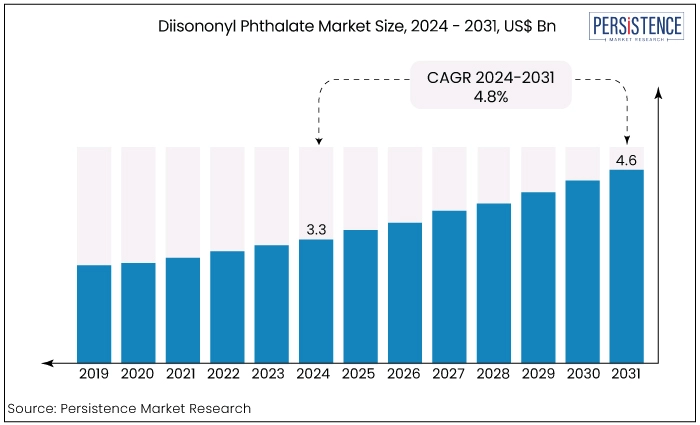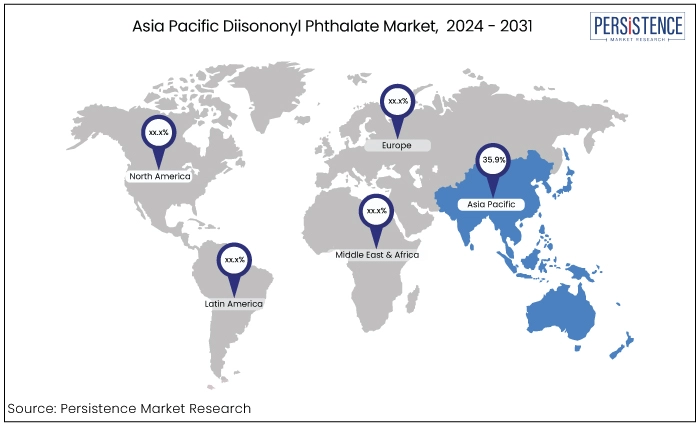Industry: Chemicals and Materials
Published Date: September-2024
Format: PPT*, PDF, EXCEL
Delivery Timelines: Contact Sales
Number of Pages: 166
Report ID: PMRREP34781
The diisononyl phthalates market (DINP) is estimated to increase from US$3.3 Bn in 2024 to US$4.6 Bn by 2031. The market is projected to record a CAGR of 4.8% during the forecast period from 2024 to 2031. The increasing adoption of DINP in high-performance applications, coupled with ongoing research into its properties, is anticipated to bolster its market presence in the coming years.

Key Highlights of the Market
|
Attributes |
Key Insights |
|
Market Size (2024E) |
US$3.3Bn |
|
Projected Market Value (2031F) |
US$4.6Bn |
|
Global Market Growth Rate (CAGR 2024 to 2031) |
4.8% |
|
Historical Market Growth Rate (CAGR 2019 to 2023) |
4.2% |
|
Region |
Market Shares in 2024 |
|
Asia Pacific |
35.9% |
Asia Pacific diisononyl phthalate market to account for 35.9% market share driven by growth in construction and automotive sectors along with increasing demand for flooring and wall-covering fabrics.
Factors such as abundant land, low raw material and labor costs, and a favorable government outlook contribute to high diisononyl phthalate (DINP) production in China and India.

DINP market due to its substantial production capacity and competitive pricing with demand primarily fueled by ongoing construction projects leading to more manufacturing plants in the country.
North America market is poised for significant growth primarily driven by a surge in manufacturing production across the region. The construction and automotive sectors are experiencing robust expansion leading to an increased demand for high-quality plasticizers like DINP.
Industries are seeking versatile materials that enhance product flexibility and durability as manufacturing activities ramp up. This rising demand not only supports the growth of the DINP market but also reflects broad economic trends positioning North America as a key player in the global landscape of plasticizer production and consumption.
|
Category |
Market Share in 2024 |
|
Application - Flooring and Wall Covering |
41% |
Flooring and wall covering is estimated to account for the 41% market share in 2024. The growing demand for durable and attractive interior solutions drives the use of DINP as a preferred plasticizer in vinyl flooring, wallpapers, and synthetic leather across residential, commercial, and industrial sectors.
DINP enhances flexibility, durability, and longevity, making these materials easier to process and maintain. This usage not only provides resilient design options but also supports the demand for sustainable, low-maintenance living and working spaces that blend functionality with aesthetic appeal.
|
Category |
Market Share in 2024 |
|
Type - PVC |
43% |
As per PMR's diisononyl phthalate market forecast, the PVC segment to dominate the market with a revenue share of 42.8%. This segment is essential for the DINP market providing flexibility and durability across various applications.
Diisononyl phthalate (DINP) is primarily used as a plasticizer in PVC manufacturing, enhancing flexibility, workability, and overall performance. Key applications include construction materials, automotive components, consumer goods, and medical devices.
The robust demand for PVC in multiple industries underscores its significance making it a vital element of the global DINP market.
The diisononyl phthalate market analysis shows a continuous growth in the market driven by several industry trends and factors. Diisononyl phthalate (DINP) is a high-performance plasticizer primarily used to enhance the flexibility and durability of polyvinyl chloride (PVC) and other polymers.
It is synthesized through the esterification of isononyl alcohol with phthalic anhydride. DINP works by embedding itself within the polymer matrix effectively reducing the glass transition temperature and allowing for great movement of the polymer chains. This results in improved flexibility, resilience, and longevity of the final product.
The diisononyl phthalate market is currently experiencing significant trends driven by evolving regulatory landscapes, growing demand for eco-friendly alternatives, and technological advancements in production processes.
As environmental concerns continue to rise, there has been an increasing push against traditional phthalates due to their potential health risks. This has led to a shift toward safer plasticizers with DINP being perceived as environment-friendly option compared to its predecessors.
The construction and automotive sectors are witnessing a surge in demand fueled by urbanization and infrastructure development, which is driving the consumption of PVC and consequently DINP. The market is also seeing innovations in bio-based plasticizers, which are gaining traction as sustainable alternatives, thereby reshaping the competitive landscape.
The diisononyl phthalate market overview has exhibited a steady growth trajectory over the past few years, with a historical CAGR of 4.2% from 2019 to 2023. The growth can be attributed to the increasing demand for flexible PVC in various applications particularly in the construction and automotive sectors where DINP is favored for its performance characteristics.
The upward trend reflects a robust recovery post-COVID-19 disruptions and a renewed focus on sustainable materials. The forecasted growth is driven by several diisononyl phthalate market trends and factors including the ongoing urbanization and infrastructure development in emerging economies, which are expected to bolster demand for PVC products.
The shift toward environment-friendly plasticizers is likely to enhance the market's appeal, as DINP is increasingly viewed as a safer alternative compared to other phthalates. The combination of regulatory pressures and consumer preferences for sustainable materials will play a crucial role in shaping the future landscape of the DINP market.
Increasing Demand for Flexible PVC
The rising demand for flexible polyvinyl chloride (PVC) in various applications is a significant growth driver for diisononyl phthalate market demand. Industries such as construction, automotive, and consumer goods are increasingly utilizing flexible PVC for its durability and versatility.
As urbanization accelerates and infrastructure projects expand, the need for high-quality flooring, wall coverings, and automotive interiors is surging. This trend is particularly pronounced in emerging economies, where rapid development is driving the consumption of PVC products, thereby boosting the demand for DINP as a key plasticizer.
Growth in the Construction Industry
The construction industry is experiencing robust growth, which directly positively impacts the diisononyl phthalate market growth. With increasing investments in residential and commercial construction particularly in regions like Asia-Pacific, the need for high-performance materials is on the rise.
DINP is favored for its excellent plasticizing properties making it ideal for applications such as flooring, roofing, and insulation. As construction activities ramp up, the demand for PVC and its associated plasticizers including DINP is expected to grow significantly further propelling market expansion.
Regulatory Shift Toward Safe Plasticizers
There is a notable regulatory shift toward safe plasticizers, which is driving the adoption of DINP. As concerns about the health effects of certain phthalates grow, manufacturers are increasingly seeking alternatives that comply with stringent regulations.
DINP is often viewed as a safe option compared to other phthalates making it a preferred choice for various applications including food-grade packaging and consumer products. The trend not only boosts the market expansion but also positions DINP as a viable solution for companies aiming to meet regulatory requirements.
Regulatory Scrutiny and Health Concerns
The diisononyl phthalate market sales are impacted by significant challenges due to increasing regulatory scrutiny and health concerns associated with phthalate exposure. Regulatory bodies, such as the U.S. Environmental Protection Agency (EPA) and the European Chemicals Agency (ECHA) are conducting thorough evaluations of DINP's safety.
As regulations tighten, manufacturers may face restrictions on DINP usage prompting a shift towards alternative plasticizers. This uncertainty can hinder market growth and deter investment in DINP production.
Competition from Eco-Friendly Alternatives
The growing emphasis on sustainability and environmental responsibility is another factor impeding the diisononyl phthalate market revenue. As consumers and industries increasingly prioritize eco-friendly products, there is a rising demand for bio-based and non-toxic plasticizers.
Innovations in alternative plasticizers that offer similar performance without the associated health risks are gaining traction. This shift poses a competitive threat to DINP, as manufacturers may opt for greener alternatives to meet consumer preferences and comply with stringent regulations. Consequently, the market for DINP could face stagnation as it competes with these emerging sustainable solutions.
Innovations in Product Applications
The diisononyl phthalate market trends have the potential to benefit from innovations in product applications across various industries. As manufacturers explore new uses for flexible PVC such as in the production of advanced automotive interiors, medical devices, and electronics, the demand for versatile plasticizers like DINP will increase.
Ongoing research into enhancing the performance characteristics of DINP can lead to its adoption in high-performance applications that require superior flexibility and durability. By focusing on innovation and expanding its application scope, DINP can secure a competitive advantage in the evolving market landscape.
Eco-Friendly Solutions
The rise of bio-based plasticizers represents a valuable opportunity to mitigate the environmental impact of DINP. Additionally, the expanding use of DINP in emerging market particularly in new construction materials, healthcare products, and innovative consumer goods offers substantial growth potential.
Continuous advancements in product formulations that comply with increasingly stringent regulatory standards while enhancing performance characteristics create significant diisononyl phthalate market opportunities. By embracing these innovations, manufacturers can position themselves favorably within a rapidly evolving industry landscape focused on sustainability and performance.
The diisononyl phthalate market is witnessing significant growth as indicated by recent market reports that underscore its dynamic character. Industry players are launching new products and integrating cutting-edge technologies to create new opportunities within the sector.
Companies are adopting critical business strategies to broaden their product lines, increase market shares in various regions, invest in research and development, and pursue global expansion to maximize market value.
Recent Developments in the Diisononyl Phthalate Market
|
Attributes |
Details |
|
Forecast Period |
2024 to 2031 |
|
Historical Data Available for |
2019 to 2023 |
|
Market Analysis |
US$ Billion for Value |
|
Key Regions Covered |
|
|
Key Market Segments Covered |
|
|
Key Companies Profiled |
|
|
Report Coverage |
|
|
Customization & Pricing |
Available upon request |
By Type
By Application
By Region
To know more about delivery timeline for this report Contact Sales

The market is predicted to rise from US$3.3 Bn in 2024 to US$4.6 Bn by 2031.
BASF SE, ExxonMobil, Evonik Industries, and LG Chem are some of the prominent companies in the industry.
PVC is the leading type and to account for 42.8% share in 2024.
Asia Pacific is the dominant regional market for diisononyl phthalate.
The rising demand for flexible polyvinyl chloride is a key trend in the market.